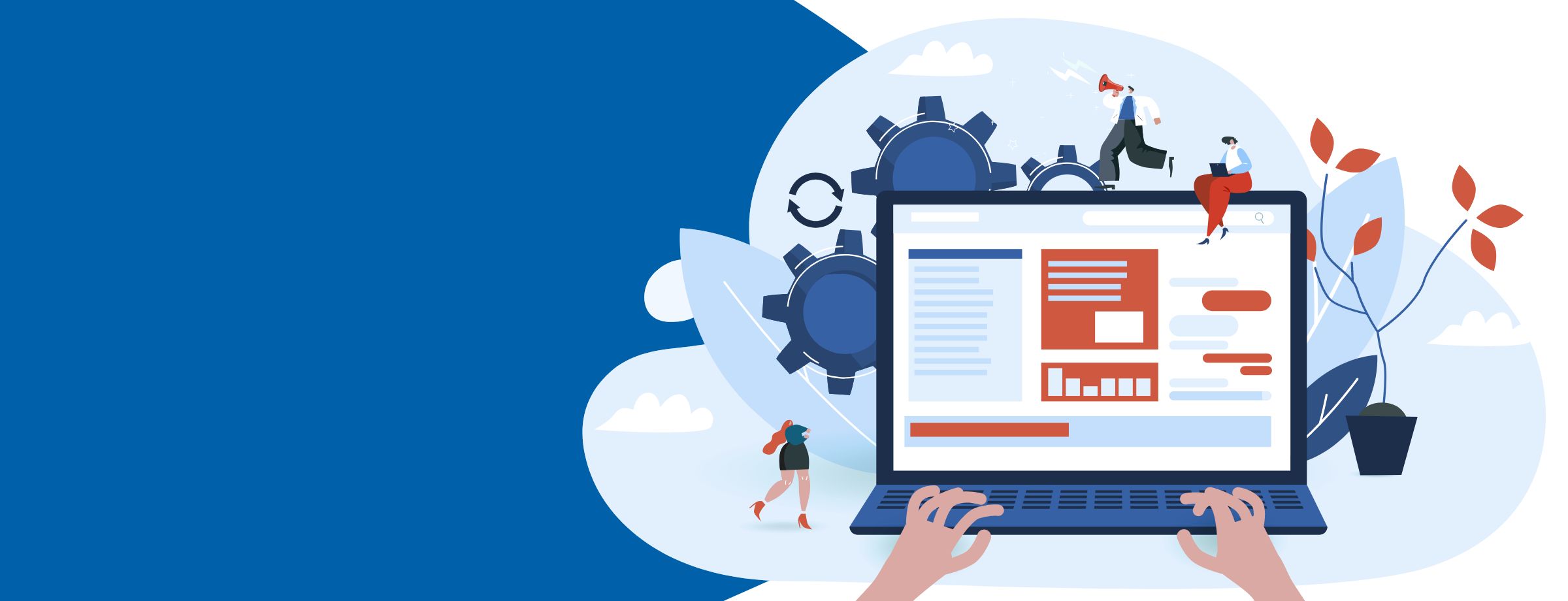So, this time, I’ll talk about something that no one really wants to do… but at the same time, the result is something everyone wants. We’ll cover spending money, some bucks, dough, moolah, cheddar, paper, stash, whatever you call it! More specifically, spending on online advertising. I know, I know. Painful!
Here, I’ll be covering why you need to advertise on top of your organic channels, what type of ads are available, remarketing, and what channels you should focus on. Getting into advertising means you need to understand the basics of distributing your content. You’ll come across some tips for each recommended social platform, too. However, you won’t find much on Instagram, as it isn’t really the best for advertising B2B content.
After trying some of these suggestions, the time you dipped your toes in the advertising pool with a $20 budget and tried AdWords for one campaign to a webpage with no call to action and didn’t see any results should be a distant memory. After all, marketing is all about strategy, rather than operations!
So, if that sounds good to you, buckle up—this one’s gonna be a doozie.
Get ahead of the game with our MSP marketing toolkit
Why advertise?
Inbound marketing, or content marketing, is definitely the prodigy marketing child of the last decade. Building thought leadership and educational content to get in front of people is organically effective and builds stronger relationships with potential leads. You should take your time in creating your content but even more time making sure it’s a-ma-zing. Write or edit your content, and after it’s published, make sure you come back to it. Spend time optimizing it and sharing it with new channels, building an audience, and promoting it. Moreover, the content golden rule of 20/80 should be top of mind. What’s that? As HubSpot puts it, “marketers recommend that you spend 20% of your allotted content marketing time creating your content—and the other 80% promoting it,” meaning you should push it out as much as you can so it can generate interest.
Something to keep in mind with content, though… creating it is not enough! It’s all about getting in front of people of their own accord and making sure they find you by being strategic with your keywords, channels, and so on. But it takes patience.
On average, blogging and SEO can take 3 to 6 months to start yielding results. And if you’re like me, we don’t have time for that. If there’s one thing I don’t have… it’s patience. And when it comes to marketing and seeing results with the money you’ve invested, I’m willing to bet that you don’t have a lot either.
Online advertising to the rescue! By taking all those sweet assets you created—or had created—for your organic strategy and promoting them, you get results faster while the search engine optimization kicks in. As you create more and more content tailored to your offering and have a more complete marketing library, you can tone down the spendings.
Building content is great, but if no one reads it, you’ll never see your ROI. This article tackles the paid, promoted way to build an audience. In later articles, we’ll be talking about your organic channels, too, so stay tuned for that!
Still unsure about advertising? Well, keep in mind that by being in control of your marketing push, you get to decide which audience you target and show your content to. That means that if you know your client profile well and define and optimize your audience, you’ll be paying for leads that are more qualified and warmer to purchases then you’ll get if you let Google and other search engines decide who they show your content to.
What’s the end goal?
Before you start to pay for advertisements, you need to think long and hard about what you want from your advertising. Then you’ll get a better idea of what to promote. Too often, I see people running social media ads directly to a webpage that wasn’t created specifically for conversions. That’s a little like inviting your whole gang of friends over to watch the Super Bowl in your canoe. It wasn’t built for that, and it won’t work.
Before putting a dime on something, make sure that it’s in tip-top shape. I always recommend building a landing page to promote something, whether it’s a service, a white paper, a booking request, or anything else. Your website is probably (hopefully) great for informing, but it’s not structured to sell or get new leads as well as a dedicated space would be. So, what’s the best way to create a landing page, you ask? Well, we have a piece written specifically on that, so make sure you read our article on landing page best practices, as it’ll greatly impact the result of your campaigns.
Then, think about your customer journey. In a well-built ad funnel and content strategy, there will be multiple types of content and ads for different purposes. You’ll want to create brand awareness campaigns with informative content that is ungated, just to build an audience and get some eyeballs on your brand. You also need to think about conversion/lead generation ads for your prospecting to build that first touch in the relationship. That type of ad will require a landing page and a form so that you can build your contact list. Of course, the content accessible via said form needs to be educational or actionable so that you’re not asking for info without giving in return.
Once you have someone’s info and you have started an informal online conversation through your brand and some pieces of content, you can start your multitouch approach through email nurturing, potentially email ad campaigns, and remarketing campaigns. More on remarketing later! By multiplying your method of contact and channels—both paid and organic—you’ll definitely get some bite and opportunities. Then all you have to do is close those leads!
Where should you be advertising? (Where your audience is!)
You got a killer offer and a landing page that’s not too shabby—now what? Channels, baby!
Think about where you put your stuff, and make sure it’s optimal. The best way to be seen is to be smart. Yes, you want to cast a wide net, but there’s no need to fish for what you don’t want, either. Who’s your typical client? What do they like? Are they online a lot? Do they use social media? Can you picture them scrolling Facebook late at night when they can’t sleep? If so, then Facebook advertising can be interesting. If none of your clients use Facebook daily, then don’t be on Facebook!
Sometimes, we try to be in too many places at once. Before you start feeling thin… sort of stretched, like butter scraped over too much bread, learn to pick the channels that will yield better results. And that starts by analyzing your clients. Stalk them online a little bit. Look for activity on LinkedIn, try to learn which communities they spend their time on, what podcasts they listen to, etc.
Once you paint a picture of what they like, slowly creep into their life with your ads. Yeah, I know how that sounds. Some people see marketing as part science and part art… well, web-based marketing is also part of being a capable, well-intentioned stalker.
The best marketing channels for IT marketing
The most used paid channels are, in no particular order:
- Google search ads display ads
- Google display ads
- LinkedIn ads
- Facebook ads
- Reddit ads
There are others, obviously, but I’m not going to waste your precious time talking about Instagram, Twitter, Snapchat, TikTok, or Pinterest ads. I’m pretty sure you’d be stretched too thin by trying to be on those platforms, as there is no way that they are low-hanging fruit for B2B IT leads. If you prove me wrong, I’ll create an article on those platforms in the future, promise! (And maybe post an apology dance on TikTok…)
What makes Google advertising so amazing?
Google offers many ways to advertise to potential clients. Paid search and display advertising are the two main options.
Search ads
By running some search ads, your content will appear on top of the organic results when someone conducts a search online, like so:
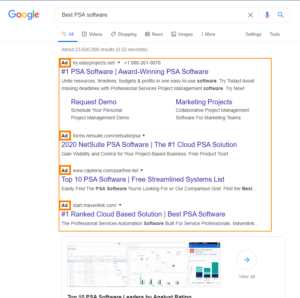
You’ll need to do keywords research and pick the queries that work best for the content you’re promoting. The keywords will also influence how much each click is worth and the budget you’ll need to set up. Ultimately, your goal should be to rank organically, but a paid search ensures you are seen on Google search engine result pages (SERP).
Display ads
The Google Display Network allows you to design banners and visual ads that will then be placed on over 2 million websites and apps, including YouTube and Gmail. You can use those banners to retarget people who have been on your site in campaigns or to get new leads. You can select which type of website you want your ads to appear on and let Google handle the automatic bidding and placement system. You can find an example of a display ad below. The HelloFresh banner on the Forbes website is not a native banner. It’s populated by the Google Display Network and changed every few minutes.
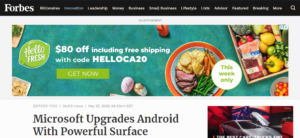
A lot can be said on Google Ads, but at the end of the day, it’s only worth knowing if you’re willing to try it. If you’re ready to get your feet wet, Neil Patel wrote a great article on ad tactics to help you get good, qualified leads with Google. Read it here.
And social media advertising?
Social media advertising across the world is projected to exceed $8.5 billion this year. There’s a reason behind that! Social media contains a great load of information about its users, and you can leverage it all through the targeting of your ads. Want to reach a niche of cat-owning single dads that love football? No worries. Senior business owners who love the outdoors? Got you covered! You can be as niche as you want or as broad as you need. Of course, Facebook knows a lot more about the demographics of its users than LinkedIn, but as part of marketing your IT business, my examples won’t get you very far. On LinkedIn, you’ll be able to target by industry, business size, titles, and more, which, if we’re honest, is a lot more in line with what you should be looking for.
Another great thing about social media advertising is that it offers a wide variety of ad formats for you to test. You get image ads, carousel ads, video ads, even one-on-one messaging ads. Play around with formats and styles. Test different messages on different audience sizes. The platforms are very intuitive to use, too.
Let’s get to the nitty-gritty
LinkedIn is probably the best place for you to be in terms of online advertising. With its 169M users in the US alone, all of which are there to talk business, you’d be a fool to ignore it.
LinkedIn highlights different types of goals with its ads: Brand awareness vs. lead generation. While brand campaigns will focus on impressions and making you more visible, lead generation ads will try to get that coveted conversion and fill your funnel of leads.
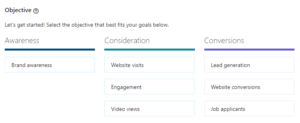
With native lead generation forms, you can even forgo landing pages and ask for your lead’s info right within LinkedIn. You also get a ton of ad types to choose from.
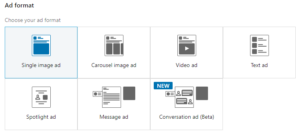
My favorites are promoted content ads, as they appear in people’s feeds and look like organic posts. Sneaky, but effective! Use LinkedIn to promote insightful and educational content. Thought leadership tactics are your best bet to get attention on that platform. People will move away from pitchy sales posts, and you’ll waste your time pitching them. Again, be benefit-centric!
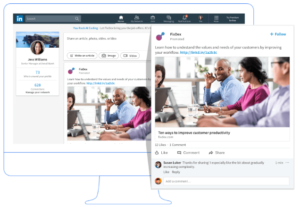
LinkedIn has built a pretty good hub for getting started with its ads. It includes resources, success stories, and more to help you get started. The platform is also pretty intuitive once you get at the campaign level. Find the LinkedIn ad best practices page here!
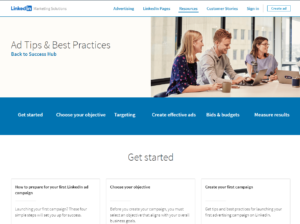
I like Facebook ads. I like them because over 30% of the world’s population has an account. However, I do not like Facebook when it comes to generating new B2B leads. Why? The network is focused on fun, family connections, and consumer brands, so talking business is not always seamless. If you have a quirky brand or a funky vertical, I say try it! But as a B2B IT consultant or MSP, you’ll probably see more success by remarketing people you’ve marketed to on LinkedIn here as well.
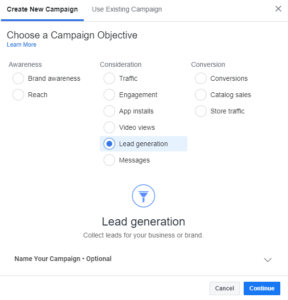
Facebook offers an ad platform similar to LinkedIn. Different types are offered, different audience specs, etc. The resource hub is very complete and should help you get started. Again, remember that Facebook’s value with MSP marketing is through remarketing, primarily. Don’t waste too much effort pitching to people as a first touch here.
If you choose to try some lead generation ads on Facebook, make sure you leverage its detailed targeting. Since Facebook has a lot of info on its users, the demographic and psychographic metrics are out of this world. You can also exclude people from your targeting based on the same criteria.
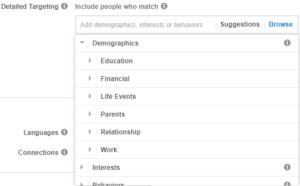
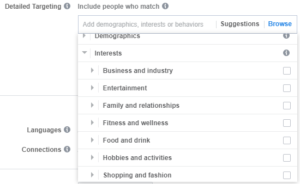
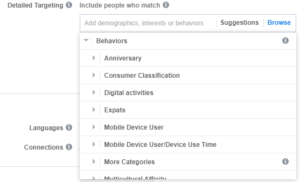
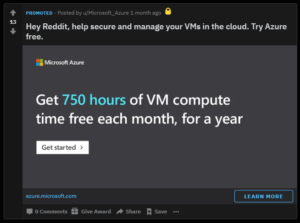
Oh, Reddit. You sweet, pure, innocent, troll-filled Reddit. If you aren’t a Reddit user, I want to tell you to skip this section. As a user, I can tell you it’s a time trap, and you’ll spend hours just reading content. If you’re curious and you love data, check out this article about what happens there. As a business person, it’s a platform that’s great only if you understand the culture around it. Reddit is filled with many, many communities, some niche, and some broader. The content is created and commented on by its users. It is known to be an open, diverse community, but beware of the trolls.
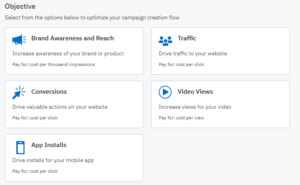
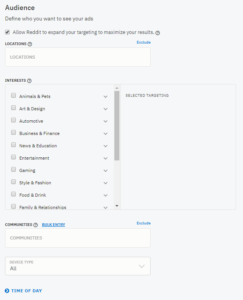
There’s a lot of snarky humor, and you need to be well versed in pop culture and memes to feel at home. So, if you’re a user and know the drill… and there’s a community that your potential clients hang out in, go for it! Reddit is often forgotten as an advertising platform, which means that the ads aren’t too expensive, and users will like seeing new ads. You’ll need to write copy that sounds like it’s native to Reddit, and you’ll need to close the comments on that ad, stat.
You see, when users find an ad that leaves the comments open, they post it on /r/UnlockedAds, which then unleashes the trolls. Your ads will soon be flooded by silly, unrelated comments. The other thing to keep in mind is that to be able to target a subreddit with your ads, it needs to have at least 2k members. If you want to learn more, check out Reddit’s ad help.
A recap :
| Platform | 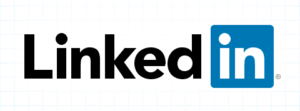 |
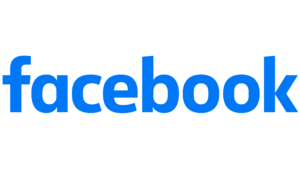 |
 |
| Bidding options |
|
|
Cost per 1000 impressions |
| Price* |
|
|
Ranges between $3.50–$100 per 1000 impressions. The minimum value is based on the location(s) of your ads |
| Control over budget |
|
|
|
| Audiences |
Good for professional audiences |
As detailed as your imagination can be |
Based on location, interest, communities (i.e., subreddits), and device types |
| Stage of journey |
Great for first touch, brand awareness, and conversion/lead generation |
Good for multiple stages, but for MSP specifically, I personally recommend remarketing |
First touch leading to brand awareness or conversion/lead generation |
| What sets it apart |
|
|
|
* All those numbers are the averages spent across industries
** https://redditblog.com/2019/01/08/technology-on-reddit/
A word on remarketing
For those of you less familiar with online advertising, here’s how remarketing works… Remember that time you were shopping for a new TV (or whatever good you needed) online, googlin’ models and brands until late into the night? And then, all of a sudden, you couldn’t believe how the same products just started popping up on websites you consulted, in your social feeds, and all around the internet? Welp, that wasn’t wizardry, it was remarketing.
When you visit sites, they send cookies or tag you through pixels, and code is placed on the page you visit. This triggers the ads to follow that cookie around. Om nom nom nom. This is incredibly useful when paired with a full-funnel marketing campaign, meaning that you use multiple pieces of content to pull a lead further down your marketing funnel into your sales cycle.
First, you get a lead with an educational ebook. If they convert, great—they’re now in your contact list, and you’re free to nurture them. If they do not convert, not all is lost. Use remarketing to show them similar or complementary content. Based on their first visit, they had an interest, but maybe you didn’t have the right hook on the first touch. Keep showing them stuff, and they might end up converting. For example, if the first campaign they saw was talking about how their Mac needs malware protection and they’re a PC user, they won’t click. However, if your next ad talks about how social engineering and lack of protection can cost their business money, they might be more inclined to click, as it’s an ad that is more in line with their concerns.
Lastly, remarketing campaigns are often cheaper, too, since the leads have heard about you before. If you’re looking to learn more about the types of ads and channels available to you, HubSpot has created a great article for you to read here.
We don’t just help with marketing, check out all our value added services with the Sherweb guide
Hold on—we’re almost finished
Online advertising seems complicated, and often, it’s just because we’re scared to try. There are a lot of benefits to investing a little bit and getting to know more about running your own marketing campaigns. There’s no need to become an expert, but mastering the basics can prove very useful. If social content is a big challenge for you, even organically, I recommend that you check out PartnerOn. Partners using PartnerOn have reported a 40% increase in sales and a 225% increase in sales leads along with improved relationships and engagement with customers and prospects! Through your partnership with Sherweb, you get free access to the platform and its campaigns. Within it, you’ll get ready-to-use collaterals and tailored campaigns for Sherweb’s Microsoft products, enough to keep those social profiles fed and generating interest.
If you have any subject you’d like me to cover, feel free to reach out to me on LinkedIn. And if you’d like to know more about what it means to be a Sherweb partner, check out our partner guide. Until next time, stay engaged!
